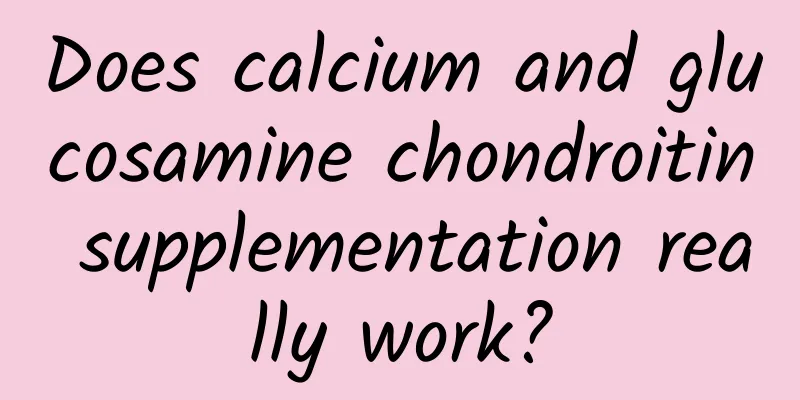Does calcium and glucosamine chondroitin supplementation really work?

|
Have you noticed that the elderly at home often complain about leg pain, pain when they stand up after sitting for a long time, pain after working, and even pain when walking in severe cases. Many people think it is calcium deficiency and recommend calcium supplementation. However, many people also give glucosamine chondroitin to the elderly. At this time, some people may feel strange, is there any difference between the two? In fact, glucosamine and chondroitin protect human joints and improve body immunity; while calcium tablets prevent osteoporosis and promote bone development. Some people say that everyone is familiar with calcium supplements, after all, pregnant women and children are taking them. So what is glucosamine and chondroitin, and is it useful? Let's discuss it today. 01. What is Glucosamine Chondroitin? —————————— First of all, glucosamine chondroitin, another name for glucosamine, is a natural amino monosaccharide. It is not only a component matrix of articular cartilage, but also widely distributed in connective tissue, skin tissue, synovial fluid, etc. The effect of glucosamine is enhanced by the presence of sulfate. Secondly, glucosamine chondroitin has two components, namely glucosamine and chondroitin, so if you want to know whether glucosamine chondroitin is effective, let’s discuss them separately. 02. Glucosamine ———— What is glucosamine? In fact, glucosamine itself is a compound in which one hydroxyl group of glucose is replaced by an amino group. Its full name is D-glucosamine, commonly known as amino sugar, abbreviated as glucosamine, also known as glucosamine. In fact, glucosamine is not a rare substance. Our human body can synthesize it because this substance is necessary for the formation of human chondrocytes and is an important nutrient for chondrocytes. In fact, for normal people, there is no need to supplement glucosamine, because the human body has been continuously synthesizing glucosamine to supplement the needs of human cartilage and maintain normal health and physiological functions. However, a major problem faced by people is aging. As we age, our bodies are generally aging, which includes not only the consumption of various energies, but also the decline of synthesis capacity. Take glucosamine for example. From adolescence, the body's ability to synthesize glucosamine begins to show a gradual upward trend, which is related to the growth of human height. At around 25 years old, the body's glucosamine synthesis reaches its peak, but then the body's ability to synthesize glucosamine begins to decline, and it shows a gradual downward trend with age, until the amount of glucosamine is far from enough to supplement the body's bones. We begin to have a series of bone problems. For example, parents often experience joint pain after doing housework and square dancing. Some people even have joint pain when walking normally. One of the factors behind this is that the lack of glucosamine leads to damage to cartilage and synovium, which is difficult to regenerate and repair [1]. It can be said that on the one hand, the human body's bones are constantly walking and moving, and are constantly wearing out, requiring constant replenishment of nutrients such as glucosamine. On the other hand, the body's ability to synthesize glucosamine has been declining, and it almost disappears by the age of 70. As a result, the human body becomes increasingly lacking in glucosamine over time. Because of this, glucosamine supplementation is also a common strategy used to make up for the nutrients needed for human cartilage. For example, in a study on the effects of glucosamine and joints, the authors administered oral ammonium sulfate glucose to Group A on the basis of using diclofenac diethylamine, while Group B did not. The results showed that the effect of Group A was significantly better than that of Group B, and was significant [2]. This also illustrates the effect of glucosamine itself, so supplementing with glucosamine is a way to deal with bone problems. 03. Chondroitin —————— After talking about glucosamine, let's talk about chondroitin. Chondroitin generally refers to chondroitin sulfate, which is a type of sulfated glycosaminoglycan with the following structure. As the name implies, this substance comes from bones. In fact, chondroitin is widely distributed in human cartilage, bones, tendons and blood vessel walls. One of its most important functions is to increase the amount of synovial fluid in joints, which can increase the cushioning and shock absorption capacity of joints and reduce wear and tear of bone joints. Like glucosamine, the normal human body can secrete chondroitin, but it also faces the problem of decreased synthesis ability with age, which leads to a relative deficiency of chondroitin. Supplementation of chondroitin has also been found to have a certain effect on protecting joints. For example, the following study investigated the molecular mechanism of chondroitin. It can be seen that chondroitin can reduce cell apoptosis to a certain extent, thereby alleviating cartilage degeneration to a certain extent [3]. This shows that chondroitin has an effect on bones themselves and can reduce cell apoptosis to a certain extent. 04. Calcium and Glucosamine Chondroitin —————————— In recent years, glucosamine and chondroitin have become important supplement demands in the current market. First of all, calcium is naturally indispensable. After all, calcium is the basic component of bones. Not only that, it is also an essential component of cell signaling pathways, so calcium supplementation is basic operation. On this basis, glucosamine and chondroitin can supplement the body's needs for both to a certain extent, replenish cartilage synovial fluid, lubricate bones, promote cartilage repair, and effectively protect joints. It can be said that there are both cartilage and bone nutrient supplements to meet different needs. Because of this, glucosamine and chondroitin supplementation is very meaningful, especially for sports groups and middle-aged and elderly people. The former often face greater bone pressure and have a greater demand for glucosamine and chondroitin, while the latter have a decrease in glucosamine and chondroitin synthesis due to aging, and both need cartilage supplementation [4]. —————————— Of course, if there are serious bone and joint problems, you still have to go to the hospital for diagnosis and treatment. In fact, the degenerative problem of joints is an objective problem. It will continue to appear with age. We can only use various means to continuously delay its occurrence and promote the health of bones and joints. [1] Zhu Jinghua, Cong Lin. A brief discussion on the efficacy and use of glucosamine[J]. Track and Field, 2021(09):84+82. [2] Xu Ying. Efficacy and safety of glucosamine sulfate in the treatment of knee osteoarthritis[J]. Agricultural Reclamation Medicine, 2021, 43(02):126-128+147. [3] Wei Qinghong. In vivo study on the inhibition of experimental osteoarthritis chondrocyte apoptosis by chondroitin sulfate[J]. Chinese Journal of Biochemical Pharmacology, 2016, 36(05): 47-50. [4] Li Chongyang, Li Yan, Mou Dehua. Research progress on the effects of glucosamine and chondroitin sulfate on bone health[J]. Food Science, 2015, 36(23): 382-385. |
>>: When are swimming crabs available? The living habits of swimming crabs
Recommend
What is the normal chest size for a 14-year-old girl?
Whether boys or girls, they all have a puberty. P...
How to fry fish in electric baking pan
The electric baking pan is a tool for cooking foo...
Is transvaginal ultrasound painful?
Vaginal ultrasound is a common examination item i...
Causes and care of bleeding during 14 weeks of pregnancy
Many expectant mothers will experience some sympt...
37 weeks pregnant, belly feels heavy
When a pregnant woman is 37 weeks pregnant, she i...
Can sesame oil be used to treat cracked nipples?
Cracked nipples are one of the common diseases du...
What tattoos are good for women?
Tattoos are loved by many people, especially in a...
What to do if your breasts sag after giving birth
Breast sagging after giving birth is a very commo...
Why does vaginal discharge turn brown?
Healthy women usually have leucorrhea, which is u...
What should women eat to replenish water in autumn?
It is said that women are made of water. It is mo...
Is it right to tilt your head back and stuff toilet paper into your nose to stop the bleeding when you have a nosebleed?
Author: Yin Jinshu, Chief Physician, Beijing Cent...
Can I do it when I have my period?
Every female friend has her period every month, w...
Can I have an abortion if my progesterone level is low?
If the progesterone level is low during the pregn...
Does laundry detergent have any effect on pregnant women? Laundry detergent, pregnancy, harm
We usually use laundry detergent when washing clo...
Why do I have abdominal pain during menstruation?
Every woman loves and hates her period. She can&#...









